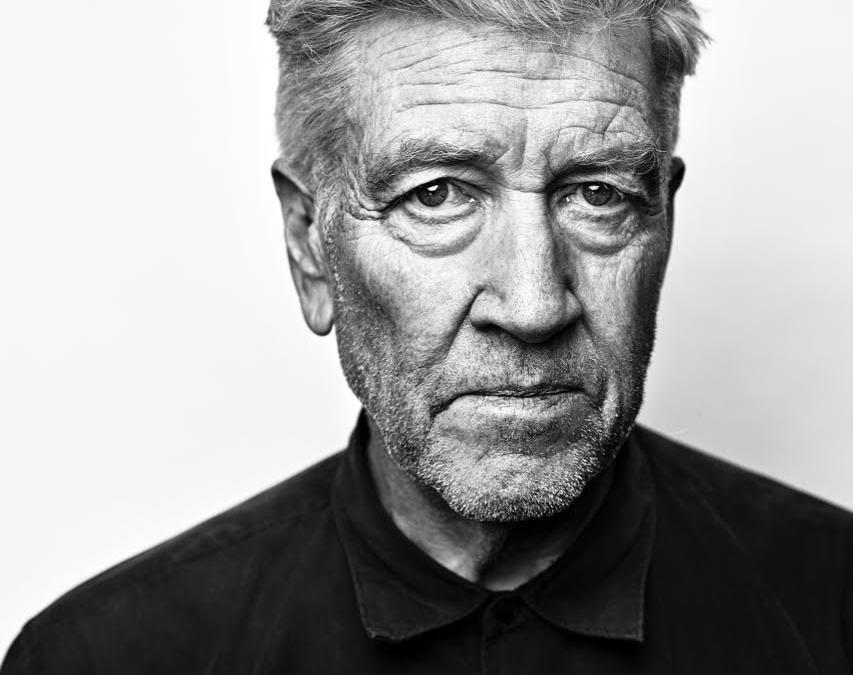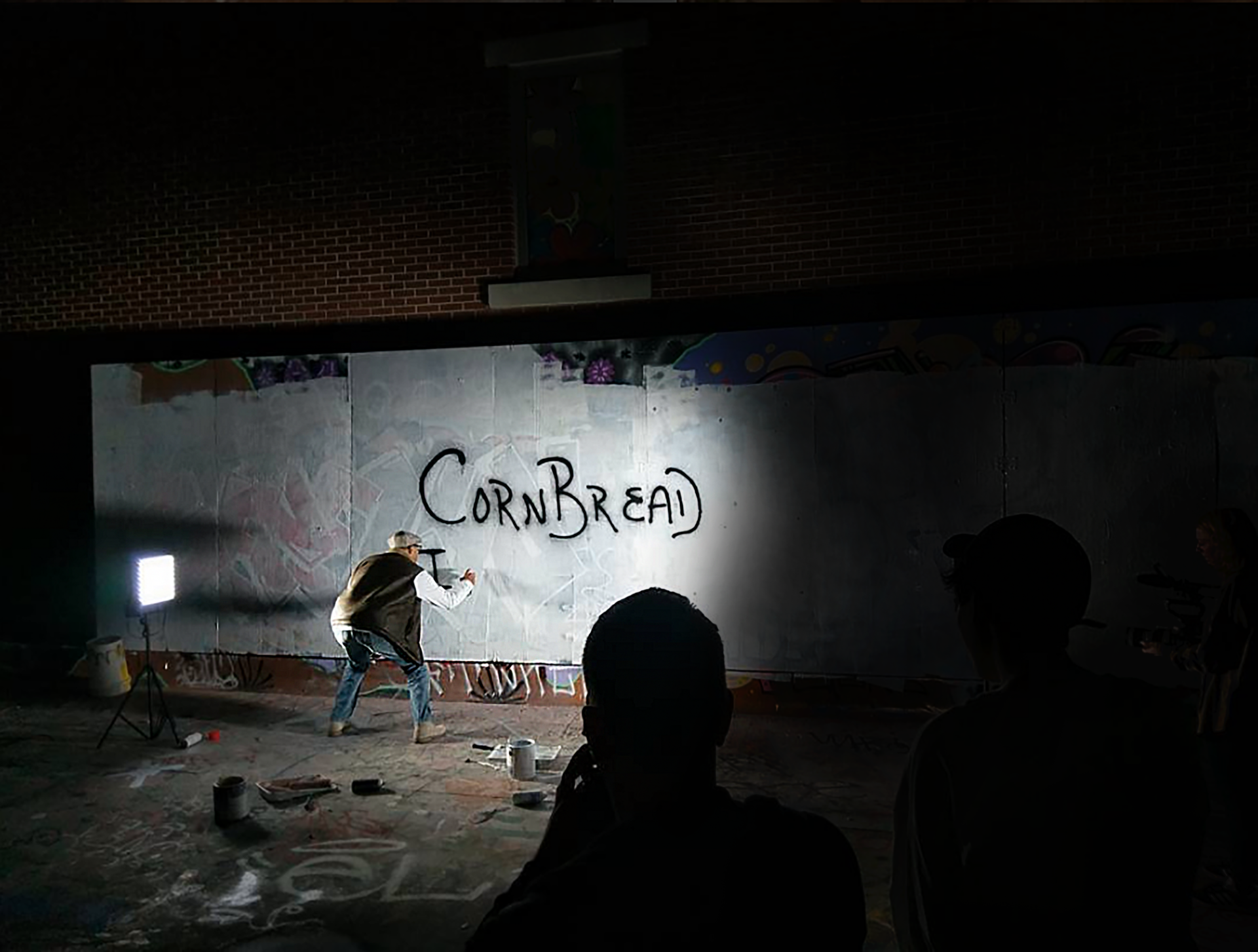David Lynch is my favorite filmmaker, ever since I first encountered Twin Peaks on VHS as a high school student in 1999, which led to me seeking out the rest of his extraordinary body of work. Lynch’s paintings and his filmography contain worlds of opposites colliding together – beauty and ugliness, menace and comedy – often at the same time. Even though there are things in his work that are deeply strange and difficult to watch, there is also an attitude of almost childlike wonder towards the world and a meticulously observed appreciation of human behavior. Mel Brooks, who produced David Lynch’s second film The Elephant Man, sums it up best. Upon seeing Eraserhead for the first time, Brooks, interviewed for Lynch’s authorized biography/memoir Room to Dream, said that he loved the movie “because it’s all symbols, but it’s real.” Everything in Lynch’s work is there for a purpose, never “weird for weirds sake.”
Watching his movies, you get the sense that even if you may not understand exactly what is happening in the moment, what you’re seeing unfold on screen is a pure expression of something deeply, truly, personally felt by the director. Interviewed by Chris Rodley for the book Lynch on Lynch, David said, “The world we live in is a world of opposites. And the trick is to reconcile those opposing things. I’ve always liked both sides. In order to appreciate one, you have to know the other. The more darkness you can gather up, the more light you can see too.”
Describing his idyllic small-town childhood for the same book, Lynch said the world he grew up in was “Middle America as it’s supposed to be. But on the cherry tree there’s this pitch oozing out – some black, some yellow, and millions of red ants crawling all over it. I discovered that if one looks a little closer at this beautiful world, there are always red ants underneath. Because I grew up in a perfect world, other things were a contrast.”
Nothing was a bigger contrast to the “perfect world” of Lynch’s childhood than the time he spent living in Philadelphia, from 1965-1970. After several attempts at art school, Lynch was somewhat adrift until his childhood friend Jack Fisk suggested he should join him at the Pennsylvania Academy of the Fine Arts. The neighborhood Lynch lived in, now affectionately known as “the Eraserhood,” was blighted by abandoned factories and violent crime. He met his first wife, artist Peggy Reavey, while living in Philly, and it was here they married and had a daughter, Jennifer Lynch, who has also become an acclaimed director.
In a 2012 interview for Philadelphia Weekly, Peggy Reavey recalled that David “was terrified, but at the same time he loved it. There were some scary times, but it was a very creative time, too.” It was while at PAFA that Lynch’s painting underwent a breakthrough, which led to him creating his first “moving painting,” Six Men Getting Sick (Six Times) in 1967. This was followed by the four-minute short film The Alphabet in 1968, and then the thirty-three-minute film The Grandmother in 1970, both of which were filmed in Philadelphia. The Grandmother caught the attention of the American Film Institute, which led to David Lynch moving to Los Angeles and where he would spend five years creating his first feature film Eraserhead. It became a successful midnight movie and brought Lynch enormous attention. John Waters told his Pink Flamingos audiences to go see it. Stanley Kubrick said it was his favorite film and screened it for the cast and crew of The Shining to show them the kind of mood he wanted to create. Eraserhead is a deeply personal vision that channels Lynch’s experiences of Philadelphia into an unsettling urban nightmare that ends in a scene of unexpected beauty and transcendence. When Mel Brooks saw it, he told the director, “You’re a madman! I love you!”
Although it has now been over fifty years since David Lynch lived in Philadelphia, the city made a deep imprint on him and has reverberated through nearly every work he has made in his career. Sometimes the Philly connections are concrete: In Eraserhead, one character lives at a house numbered 2416, the address of one of the several houses Lynch lived in. One of the other places he lived was opposite a morgue, and Lynch recalled watching the body bags being washed out and then hung up to dry outside, looking like “smiling bags of death.” This exact image would show up in Twin Peaks over twenty years later, and the characters of FBI agents Dale Cooper, Gordon Cole, and Albert Rosenfeld all hail from the Philadelphia office, with several scenes taking place there.
The city’s influence is also resonant in physical locations: the bleak factory neighborhood of Eraserhead, the Industrial Revolution backdrop of Victorian London in The Elephant Man, the logging industry towns featured in Blue Velvet and Twin Peaks, and the wintry factory world of Łódź, Poland is a pivotal location in INLAND EMPIRE. More than all this, though, it is the mood and feeling Lynch experienced while living in Philadelphia that has echoed through his body of work – a sensation of fear and violence, a world spinning out of control populated by characters who are trying to either find their own balance or perpetuating the chaos, with sudden moments of extraordinary joy and humor amongst the darkness and oddity of life. As one character muses in Lynch’s Palme d’Or winning 1990 film Wild at Heart, “This whole world is wild at heart and weird on top,” an assessment that also feels descriptive of the city of Philadelphia and its unique, rebellious spirit. David Lynch said in the 2016 documentary The Art Life: “Philadelphia was just perfect to spark things…It was so good for me. Even though I lived in fear, it was thrilling to the live the art life in Philadelphia at that time.”
Philadelphia has embraced David Lynch back: the Eraserhood has many events that celebrate the neighborhood and his association with it, and during the 2019 Philly Fringe Festival, theater company The Antidote had a sold-out hit with the devised play Red Lodge, Montana, created as a love letter to Lynch’s filmography and performed in the basement of the Bok building, which was an abandoned high school locker room.
At the start of the pandemic, David Lynch began his own YouTube channel, David Lynch Theater, where he has released several film projects as well as a daily weather report and a daily lucky number. Given that Lynch resides in Los Angeles, the weather reports almost always predict “blue skies and golden sunshine!” For an artist whose canvasses and films are filled with darkness, it surprises many people that David Lynch the person comes across as serene. Lynch began practicing Transcendental Meditation in 1973 and has spoken about how it changed his outlook on life and made it easier for him to “catch ideas” and let go of negative emotions, which he has said are “the enemy of creativity.” In 2005, he created the David Lynch Foundation, a non-profit organization to bring the teachings of TM to at-risk youth, war veterans, prison inmates, and those experiencing homelessness. Especially in our current world, it’s an organization devoted to positive change.
On the day that I was scheduled to interview David Lynch for this article – March 16, 2022, three days before the 45th anniversary of the 1977 premiere of Eraserhead – I watched his “Today’s Number Is…” and the number he pulled was seven. A little later I was rewatching an episode of Twin Peaks: The Return, in which a pivotal character is revealed to work at the Lucky 7 Insurance Agency. As Special Agent Dale Cooper once said, “When two separate events occur simultaneously pertaining to the same object of inquiry, we must always pay strict attention.”
[The following interview has been lightly edited for length and clarity.]
JH: The first question I’d like to ask is what brought you to Philadelphia originally?
DL: To go to the [Pennsylvania] Academy of Fine Arts.
JH: What was Philadelphia like when you first arrived?
DL: Philadelphia, Pennsylvania was…a hellhole. It was filled with fear, and corruption, and it was filthy, there was soot on the buildings and there was a lot of kind of insanity and a feeling in the air that was very uneasy. But it was the greatest place for me, and I just loved it. And it was my biggest inspiration, this city of Philadelphia.
JH: What do you think it was about the atmosphere of Philadelphia at the time that became so inspiring for you and your work?
DL: Just what I said. The way the buildings were, the mood of the place, all these things feed into us, and our environment affects us a lot, and it sort of crept into me and like I said it made a huge impression and influence. And I always say – people say, “what was your greatest influence” and I always say, “the city of Philadelphia.” It a unique city. They say it’s a little New York but it’s way different. The way the architecture is and the wood and the colors and the proportions of the buildings, along with the mood, and the people, and the kind of corruption feeling in the air, it was just, you know, unique. Fantastic.
JH: It was while you were at the Pennsylvania Academy of Fine Arts, I believe, that you had the first instance of looking at one of your paintings and seeing movement there. Could you tell me a little bit about that?
DL: First of all, all I ever wanted to be since I was in the ninth grade was a painter. So, I ended up at the Pennsylvania Academy of Fine Arts in Philadelphia, and at that time the school had, in one of the big rooms they had proportioned off little cubicles. I mostly painted where I lived – I lived with my friend Jack Fisk and a guy named Richard Childers at 13th and Wood – but I also had a little cubicle in one of the big studio rooms at the Academy. And I was in there one night, and I was painting a picture of a garden at night. It had a lot of black and this green kind of coming out of the black, and I sat back, probably to take a smoke, looking at this painting, and I suddenly heard a wind coming from the painting, and the green started to move. And I thought, “Oh, a moving painting.” And that experience led to cinema.
JH: I read in Room to Dream that when you were living in Philadelphia with your first wife, Peggy Reavey, that there was a blue velvet sofa that you had in your house that you both loved but weren’t able to take with you. Was that sofa a piece of what led to Blue Velvet for you?
DL: No. I don’t even know if it was velvet, the couch, it might have been. It was absolutely beautiful. It was very long, that couch was longer than most couches and it was in pristine condition. It had this real minimal, very dark beautiful wood and not like filagree, just pure. And we got this couch at Goodwill, and in those days this Goodwill was like if you had died and went to heaven to be in this Goodwill. If I needed a shirt, I’d go there, and they had long racks of beautiful shirts organized by size and make. And I could go through and find – I found three shirts that I loved that were like brand new, starched, clean, perfect shirts. I took them to the counter and laid them on the counter and I said, “How much?” And they said, “Thirty cents.” So, you could get in this Goodwill, things that would curl your hair. Unbelievable, beautiful things, for almost nothing. I got so many fantastic lamps, and I got the furniture, just on and on and on. You’d go in there and you’d just go crazy. The wealthy out in the Main Line were giving away the stuff, and the Goodwill’s now are completely different but in those days that Goodwill was so special. That’s where that couch came from, and it was a beauty. I think it cost twenty dollars but was probably, in those days, I don’t know how much it was, but it was a very expensive couch that we got for twenty dollars.
JH: You’ve spoken in the past about how Eraserhead is your Philadelphia Story, and watching it, to me it really does capture the feel of Philadelphia, even though of course the city’s changed a lot, but there are still pockets of it that are very much that. For you – and you might not want to say this – but for you is Eraserhead set in Philadelphia or is it its own world?
DL: It’s its own world, really, but inspired totally by Philadelphia.
JH: When you had your exhibition a few years ago at the Pennsylvania Academy of Fine Arts, was that the first time you’d been back to Philadelphia since the early days?
DL: I was back once before that. But on that trip, when I had my show at the Academy, I realized once again what a great city Philadelphia is. And the people were so great. So, I was so happy to have that show there and get reacquainted with Philadelphia. It’s just…it’s a great city.
JH: When you were in Philadelphia for that trip I saw you at the Free Library of Philadelphia, and you said something that has really meant a lot to me as an artist: “As a director, you owe it to yourself to stay true to the idea you fell in love with.” Philadelphia is still a city that is filled with artists of all kinds, and a city that really embraces you and your work. What advice would you have for the artists of Philadelphia today?
DL: What you just said, “Stay true to the idea.” Ideas are the thing. An idea tells you what you’re going to do and how you’re going to do it. We’re nothing without an idea, we wouldn’t know what to do without an idea. Even saying, “I would like some coffee,” that’s an idea, and it leads you to go get some coffee. It’s like a thought, or an idea, is so important. And when you get an idea that you fall in love with, that is a beautiful gift to you. And so, you see the idea, and if it’s a cinema idea you hear it, you feel it, you know it, you write it down, so you won’t forget it, and then you translate that idea to cinema. And you stay true to that idea, every element, you check back with the idea. “Is this right? Is this the same feeling as that idea? Am I doing it right? Is this thing right? Is this thing right?” And you keep checking back with the idea, and you let the idea guide you, and then you have the thing. Stay true to the idea and enjoy the doing. Enjoy the doing. And in this world that is so filled with stress and torment these days, a lot of times it’s difficult to find that bubble of happiness inside that allows you to enjoy the moment to moment enjoying of your work. And so, I always tell people to practice Transcendental Meditation as taught by Maharishi Mahesh Yogi. Learn this technique – it takes about four days, about an hour and a half a day, and you’ve got the technique for the rest of your life – and you meditate twice a day, twenty minutes in the morning and twenty minutes in the afternoon, and then go about your business and watch things get very, very, very good. You get happier, you get more intelligence, more creativity, more love, more energy, and more inner peace. And the negative things you’ve been packing up inside start to dissipate and evaporate, giving you tremendous freedom. Gold will start coming in from within, and negativity garbage will start going out, and you’ll have a great, great time in life catching ideas, and realizing those ideas, and be happy in the doing.
JH: Thank you so much, Mr. Lynch. And just finally I wanted to say you have been one of the biggest influences on my artistic life. I want to thank you, in particular, for telling the story of Laura Palmer. That has meant a great deal to me and to so many other people, and thank you for all of your stories, both in cinema and on canvas. And speaking with you today has been one of the great honors of my life. Thank you so very much.
DL: Bless your heart, Josh! It was good talking to you, man! All the best to you and all the best to Philadelphia!
–
Stay weird and wonderful, Philadelphia. I think David Lynch would be very proud of us.


